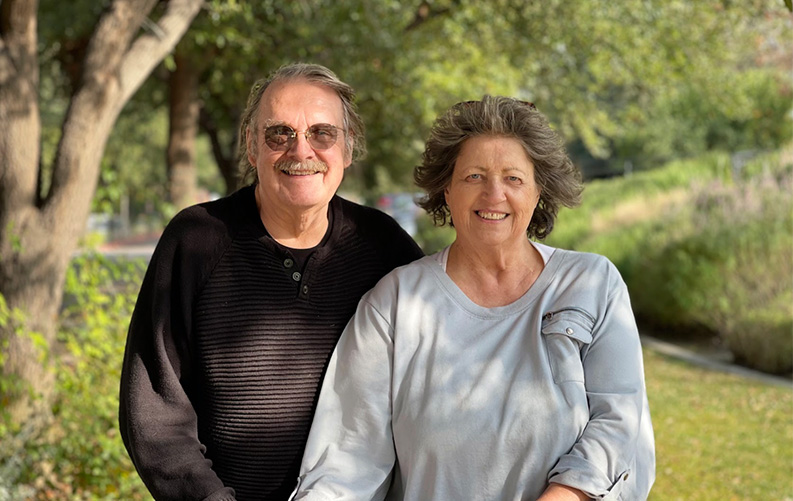We’re Stronger Together
With your help, we can make ambitious innovations in clinical care and education for our community.
Enter your email to start your free information request.

In February 2020, Jan Griffith, a 68-year-old retiree from Redlands, California, was shocked to learn she had breast cancer. Luckily, an overdue mammogram caught it early – at stage zero. But Griffith had to get through four grueling rounds of chemotherapy and debilitating nausea and sickness that came with it. She was grateful that what she assumed was the most challenging part of having cancer was over.
The following November, Griffith learned that wasn't the case. “I started feeling tingling in my toes and the tips of my fingers,” Griffith says. She was experiencing neuropathy, one of the chemotherapy side effects she'd been warned about. Neuropathy is nerve damage that causes tingling, numbness, and muscle weakness.
The tingling progressed until Griffith's toes and feet became numb. After seven weeks, Griffith couldn't walk and couldn't get out of bed. “I was numb from my toes to my knees. I had to move my legs to know where my feet were,” Griffith says. Her hands and fingers went numb, too. “I purposely bit my index finger and couldn't feel a thing.”
Unfortunately, what Griffith could feel was excruciating pain even with the numbness. “It was constant and horrific,” Griffith says. “I felt like I was being electrocuted.”
Medication for the neuropathy and home therapy didn't help. So, in February, she saw a Loma Linda University Health neurologist who referred Griffith to the Loma Linda Neuropathic Therapy Center. The center specializes in Intraneural Facilitation (INF™), a breakthrough therapy that restores blood flow to damaged nerves and reduces neuropathic pain, tingling and numbness.
On her first visit, physical therapist Mark Bussell, DPT, MS, OCS, asked Griffith to do alternating therapeutic holds and stretches. She quickly realized that this was unlike any treatment she had previously experienced. Griffith admits, “It was weird. I'm lying on the table thinking this is probably my last visit.”
But it didn't take long for Griffith to become a believer. “Dr. Bussell said he wanted to see what he could do about my left leg,” Griffith says. “It had been bent at a 90-degree angle since I had become bedridden.” After 30 minutes of alternating holds, she was able to straighten her leg.
“It's all about reflex points and blood flow,” Griffith says. “Blood flow to nerves and feet is critical.”
With additional visits to therapy, Griffith could move her legs. Then, she stood and took steps on her own. Her husband, Walt, cried.
Griffith still has numbness, but the feeling has returned to parts of her feet, and the electrocuting pain is gone. “I have some pain, but it's pain from the nerves beginning to work and heal. Therapy helps,” Griffith says.
Thanks to the therapy, Griffith has a life again and a new focus. “There's so much I can do,” she says. “I can dress myself. Using a walker, I can go outside, get in and out of a car. I can stand at a stove and scramble eggs or sit at the breakfast bar and boss my husband.”
Griffith says she has hope, too, as she continues therapy twice a week. “My story's not complete because I see what's happened so far,” Griffith says. “The pain is less. I can move my fingers normally and grip. I'm walking, and my legs are getting stronger. These therapists are an amazing group of people. I'm grateful for what they do.”
If you’re suffering from nerve pain, our Neuropathic Therapy Center may be able to help using a breakthrough physical therapy treatment called Intraneural Facilitation or INF.™ For more information and to schedule an evaluation, call 909-558-6799 or request information online.
With your help, we can make ambitious innovations in clinical care and education for our community.